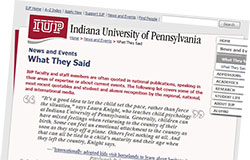IUP’s Nursing and Allied Health Professions degrees are some of our most rigorous programs, and for good reason–the things that the students learn there ARE a matter of life and death.
The faculty work very hard to create real-life experiences for students, so they are well prepared for work in hospitals and other health care settings. In September 2010, faculty members Lisa Palmer and Julia Greenawalt were successful in receiving amost $300,000 to create a simulation lab, which mirrors the home of a rural patient with a common chronic illness. The lab is designed to help train nurses for home health care especially and includes telehealth monitors used by home health care agencies. Dr. Palmer explained that with the shortage of nurses, more and more patients are being treated in their homes, and this laboratory offers a significant advantage to IUP students who go on to work with home health care agencies.
This new home health care simulation lab adds to the department’s current simulation laboratory, established by the department in 2007 and renovated in 2009. This lab includes manikins of all “ages,” including an infant, two simulated hospital rooms, and IV and other training devices.
While this laboratory gets very heavy use by students and faculty and will undoubtedly help future nurses save lives, it was the site of a very unusual project this summer.
David Altrogge, a 2006 IUP art studio/graphic design graduate, is making a name for himself as a cofounder and creative director of Vinegar Hill, a full service production company and creative agency based in Indiana. IUP has used his company for projects, and he has used IUP and Indiana places and spaces for several of his productions.
David recently was contracted by Centricity Records to produce a music video for Aaron Shust’s My Hope Is in You. The story is about a couple waiting as their daughter is treated in a hospital following an accident. I won’t give away the ending, but you might want to have a few tissues handy while you watch it.
If you’ve ever visited Johnson Hall (home to the department), and the “hospital” in the video looks sort of familiar to you–well, that’s because it is. IUP’s Nursing and Allied Health Professions Department’s simulation lab is the hospital, and the hospital lobby is the lobby of the Nursing department in Johnson. The video features several IUP Nursing graduates, including Megan Wallwork (doing chest compressions), Janelle McCombie, and Kristi Altrogge. The Bennets, of Indiana, are the grieving parents.
While IUP is proud of David’s work, we are also proud to know that the simulation lab did exactly what it was supposed to do, albeit in a fairly unorthodox setting: It offered a very real hospital environment, with a realistic patient and believable injuries. A win-win for all involved.

